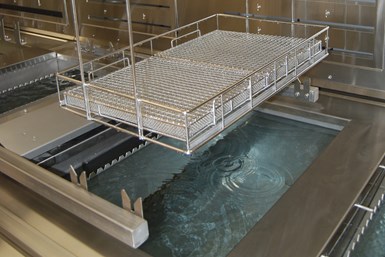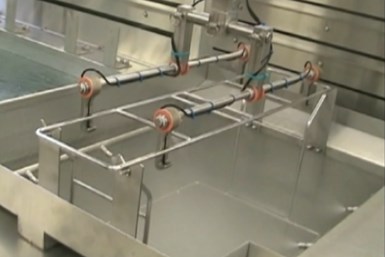Considerations for Bringing Passivation In House
If passivation is often required by your customers, moving this process in house can save time and money. However, it involves proper chemical handling and safety, compliance, equipment design and setup, and budget.
Bringing secondary operations in house can be a consideration when it makes sense for an operation to do so. It can be a time- and money-saving strategy for a company and a benefit to customers.
For example, if a secondary operation such as passivation is often required by a company’s customers, moving this process in-house can eliminate turnaround time that is spent sending parts out to another facility to complete the job. However, the feasibility of bringing this process in-house involves proper chemical handling and safety, compliance, equipment design and setup, and budget.
Passivation is a chemical cleaning process that removes free iron (as well as dirt and grease) from stainless steel parts. When correctly passivated, the metal surface will spontaneously form a passive metal oxide film that protects the surface from corrosion and rust. The resulting metal surface should appear clean and show no pitting, etching or frosting.
The two types of passivation — nitric and citric — are detailed in The American Society for Testing and Materials (ASTM) specification A967. The specification establishes bath chemistry volumes and temperatures, and the proportionate amount of exposure time for parts. It also provides various tests to validate the process.

This enclosed, automated cleaning and passivating line with vacuum dryer is built to meet space requirements and throughput goals. Photo credits: Miraclean
Historically, nitric acid has been the passivation chemistry of choice, although it is a hazardous material that requires respectful use. As part of a passivation process, nitric acid will typically be confined to a tank in a certain volume and may or may not be heated, depending on the nitric ASTM A967 type specified by the customer. The potential for operator exposure must be controlled when preparing or disposing of the bath and when processing parts.
More recently, citric acid passivation has been growing in acceptability. If a customer specification allows for citric acid passivation, it is more user friendly and typically more disposal friendly than nitric acid. Still, citric acid formulations should be used according to safety data sheet guidelines and government regulations, which include safe handling practices and personal protective equipment.
Safety Regulations
The use and disposal of chemistries are subject to local, state and federal regulations. Typically, keeping the nitric tank’s liquid waste stream separate from the remainder of the process is recommended. By doing so, the waste stream can be periodically containerized and hauled off for disposal. Those with waste treatment or pH neutralization systems on site may choose to route the nitric effluent through those systems prior to disposal in accordance with government regulations.
Nitric acid air emissions are also subject to allowable thresholds, depending on local jurisdictions. Large tanks and/or companies that use a lot of nitric acid may need to operate nitric fume scrubbers to meet government limits. Heated tanks should be ventilated and covered, if possible, when not in use.
Clean Parts First
Whether performing nitric or citric passivation, cleaning the parts first is imperative. ASTM specification A380 covers parts cleaning options in-depth. Unless cleaning is performed elsewhere (and often even if it is), including at least one cleaning tank with ultrasonics and/or agitation and two or more rinse tanks prior to the acid passivation is suggested. This assures that the parts are freshly cleaned and rinsed prior to the passivation step and extends the life of the passivation bath.
Process Setup
A passivation system may consist of individual freestanding tanks or may be

a multiple-station console consisting of individual tanks mounted in a countertop. The console approach keeps chemistries more contained when baskets/fixtures are moved between process steps. Either way, a secondary containment tray placed underneath is useful to capture any spills.
Console systems or individual tanks should be sized to allow solution exposure to all part surfaces. The systems or tanks may be manually operated with timers and an operator who lifts and moves the load between stations or automated via a PLC-controlled programmable hoist. If automated, the hoist performs all of the operating functions once the batch is loaded into the system. The automated hoist advances a load when the required process time in each tank has been met and provides additional assurance that the passivation has been performed according to the validated protocol.
Acid Passivation Bath
The acid passivation bath may or may not be heated, depending on the type of passivation being performed. For versatility, companies can equip the acid bath with heat and exhaust, and simply not use the heat unless and until a recipe requires. The tank supplier should be informed of the type, highest concentration and temperature of acid chosen so it can recommend the chemistry-appropriate tank and plumbing materials.
To meet higher throughput requirements, more than one acid bath or multiple acid zones (subdivisions of a larger single bath) may be desirable to increase productivity because required acid exposure time is a limiting factor.
A mechanical action in the acid bath (such as ultrasonics or air agitation, or recirculation of solution) keeps the chemistry evenly distributed in solution.
Concentration of the acid can be manually monitored periodically or can be continuously monitored on automated systems with optional conductivity metering for citric acid or specific gravity for nitric acid. The pH may also be monitored manually or automatically.
Rinsing
The acid passivation step is followed by rinses, preferably two or more counterflow rinses to conserve water use. These rinses are heated to optimize performance and promote flash drying of the parts upon exit when the rinses are the final wet steps.

Rinsing after acid passivation may include spray off as well as immersion. At least two rinses are ideal.
Rinse water quality is critical to minimize the potential for spotting or staining on the parts, which will cause them to be rejected during visual inspection upon completion. We recommend deionization or reverse osmosis water throughout the process, if possible, and especially for rinsing.
Post-Treatment
Some customer specifications require additional post-acid steps. These may include neutralization of the acid activity in a separate bath using a base chemistry according to the customer’s approved concentration, temperature and exposure duration. Another post-treatment may be a sodium dichromate or peroxide dip per an acceptable recipe, which accelerates the natural formation of the metal oxide layer.
Both neutralization and post-treatment would be followed by rinses, preferably at least two. Rinsing should be followed immediately by some type of drying procedure such as air blow off, recirculating hot air and/or vacuum dry.
Verification and Validation
ASTM A967 and A380 provide several post-passivation tests to verify the success of the process on parts. In addition to passing visual inspection, these tests include water immersion, high humidity, salt spray and/or copper sulfate. The testing methods and verifications are detailed in the ASTM specifications.
Validation of the successful process will typically include demonstrating that the passing results can be repeated within the allowable range of chemistry concentration and temperature at various points such as the low, middle and high ends of concentration and temperature.
Once validated, maintaining a well-functioning passivation process requires continuing to rack or fixture parts so the solution can move throughout the load. It also includes regularly monitoring and tracking acid tank concentration, temperature and part exposure time to verify conformance to the recipe and the validation. Record keeping will be in accordance with the standard operating procedure and customer specifications. Automated systems equipped with chemistry and temperature control devices and data logging can track all these critical parameters continuously.
Multiple Acid Systems
Both nitric and citric passivation can be done in the same line if each acid has at least one dedicated rinse prior to the final rinse.
Systems may also be built with separate tanks for more than one recipe of the same acid. For example, an ambient tank with a lower concentration of nitric acid can also run within a system that includes a heated nitric tank that operates at twice the concentration. In this scenario, having two tanks conserves chemistry by minimizing the need to prematurely drain chemistry to change a concentration and saves the time and material handling required to do so.
The National Institute for Occupational Safety and Health (NIOSH) website as well as product safety data sheets offer guidelines for safe nitric acid use. They include adequate ventilation and the use of personal protective equipment.
Miraclean | 716-763-4343 | miraclean.com
About the Author
Cheryl Larkin
Larkin is the northeast regional sales manager at Miraclean. She can be reached at clarkin@cmfs.com or 908-420-0245.
Read Next
Developments for Higher Precision in Ultrasonic Cleaning
Today's high-tech automated systems meet exacting standards.
Read MoreA ‘Clean’ Agenda Offers Unique Presentations in Chicago
The 2024 Parts Cleaning Conference, co-located with the International Manufacturing Technology Show, includes presentations by several speakers who are new to the conference and topics that have not been covered in past editions of this event.
Read MoreEpisode 45: An Interview with Chandler Mancuso, MacDermid Envio Solutions
Chandler Mancuso, technical director with MacDermid Envio discusses updating your wastewater treatment system and implementing materials recycling solutions to increase efficiencies, control costs and reduce environmental impact.
Read More








.jpg;maxWidth=300;quality=90)












